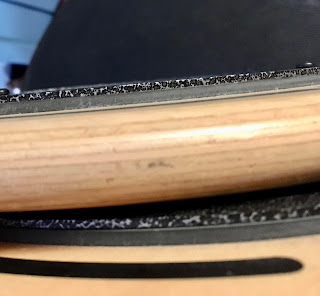I picked up this pair of practice pads a couple of weeks ago in an online sale.
I was able to research the patent and the maker thanks to Google Patents, and from there I located the inventor, Denny R. Dennis, through Facebook. I asked if he’d mind talking a little bit about his invention, and he gave me a phone number so we could chat.
Denny is a longtime drummer based in Southern California, and is the father of Ty Dennis, who has enjoyed his own top-drawer career. (“Be sure you look up my son,” Denny told me. Very sweet.)Denny developed these pads in order to provide the drummer with a way to practice drumming more melodically, by providing pads with different pitches. Each pad is made from maple plywood, and has a thin rubber playing surface and thin metal rim on top. On the bottom of each pad are three “feet” with Velcro pads, allowing the pad to rest on a specially prepared stand. There should be small pieces of rubber on the bottom layers of Velcro, but my pads did not have these. (I may add my own later.)
The rubber provides additional stack height to give the pad some space for greater resonance, because resonance is the point with differently-pitched pads.
The pads are attractively finished, and according to Denny they came in multiple sizes to approximate the different drum sizes of a drum kit.
Mine are both 12” across, with a playing surface of just under 9”. Denny originally designed the pads in sizes ranging from 12” to 18” and even used the largest as a bass drum pad with a pedal affixed.
The rubber playing surface is very thin, perhaps only 1 or 2 millimeters thick, but is glued to the wood and gives off a surprising amount of resonant tone.




No comments:
Post a Comment